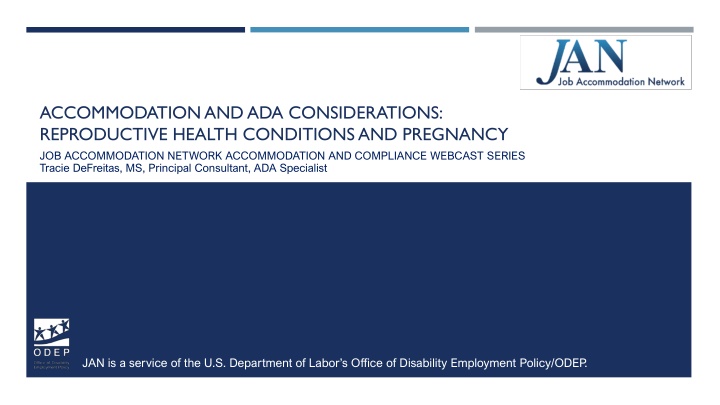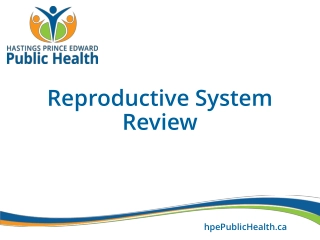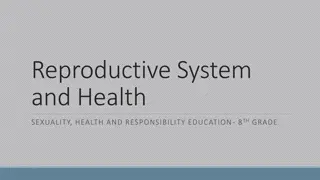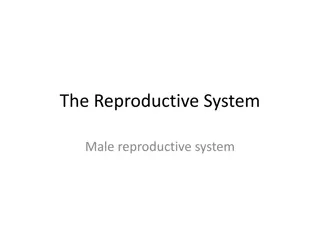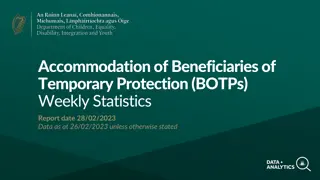Reproductive Health Conditions and Accommodation Considerations
Reproductive health conditions, such as endometriosis, uterine fibroids, and interstitial cystitis, can impact individuals in the workplace with symptoms like pain, infertility, and discomfort. Understanding these conditions and their effects is crucial in providing appropriate job accommodations and ensuring compliance with ADA regulations.
Download Presentation

Please find below an Image/Link to download the presentation.
The content on the website is provided AS IS for your information and personal use only. It may not be sold, licensed, or shared on other websites without obtaining consent from the author.If you encounter any issues during the download, it is possible that the publisher has removed the file from their server.
You are allowed to download the files provided on this website for personal or commercial use, subject to the condition that they are used lawfully. All files are the property of their respective owners.
The content on the website is provided AS IS for your information and personal use only. It may not be sold, licensed, or shared on other websites without obtaining consent from the author.
E N D
Presentation Transcript
ACCOMMODATION AND ADA CONSIDERATIONS: REPRODUCTIVE HEALTH CONDITIONS AND PREGNANCY JOB ACCOMMODATION NETWORK ACCOMMODATION AND COMPLIANCE WEBCAST SERIES Tracie DeFreitas, MS, Principal Consultant, ADA Specialist JAN is a service of the U.S. Department of Labor s Office of Disability Employment Policy/ODEP.
2 HOUSEKEEPING Technical Difficulties Use the Q&A option at the bottom of the screen 800-526-7234 or 877-781-9403 (TTY) - or Live Chat at AskJAN.org Frequently Asked Questions (FAQ) AskJAN.org/Training/JAN-Webcast-Frequently-Asked- Questions.cfm AskJAN.org/Training/JAN-Webcast-Frequently-Asked-Questions.cfm AskJAN.org/Training/JAN-Webcast-Frequently-Asked-Questions.cfm Questions for Presenters Use the Q&A option at the bottom of the screen
3 HOUSEKEEPING 2 PPT Slides Click the link included in the webcast login email you received, see the link in the chat, or go to this webcast event from the Training page at AskJAN.org Captioning Use the closed caption (CC) option or captioning link in the chat
4 DISCUSSION Summary of Common Reproductive Health Conditions Common Symptoms and Limitations and Effect on Working Accommodation and Compliance Considerations
5 ABOUT REPRODUCTIVE HEALTH CONDITIONS Reproductive health refers to the condition of our reproductive systems during all life stages These systems are made of organs and hormone-producing glands, including the pituitary gland in the brain Reproductive Health, National Institute of Environmental Health Sciences (NIEHS)
6 COMMON REPRODUCTIVE HEALTH CONDITIONS Endometriosis Affects a woman s uterus. Tissue that normally lines the uterus can grow on the ovaries, behind the uterus, on the bowels, or on the bladder, causing pain in the abdomen, lower back, or pelvic areas, infertility, and heavy menstruation. Endometriosis, MedlinePlus Uterine Fibroids Noncancerous tumors made of muscle cells and other tissues grow in and around the wall of the uterus, causing heavy and/or painful menstruation, lower back pain, fullness in the lower abdomen, and frequent urination. Uterine Fibroids, MedlinePlus Interstitial Cystitis (IC) Chronic bladder condition resulting in recurring abdominal or pelvic pressure and discomfort, frequent and/or urgent urination, tenderness, intense pain in the bladder or pelvic region, severe lower abdominal pain that intensifies as the urinary bladder fills or empties. Interstitial Cystitis, MedlinePlus
7 COMMON REPRODUCTIVE HEALTH CONDITIONS (2) Polycystic Ovary Syndrome (PCOS) Condition where the ovaries or adrenal glands produce more male hormones than normal. Results in pelvic pain, excess hair growth or baldness or thinning hair, acne, oily skin, dandruff, or infertility. Increased risk of diabetes, heart disease, anxiety, and depression. Polycystic Ovary Syndrome, MedlinePlus Premenstrual Dysphoric Disorder (PMDD) Chronic condition where hormone levels begin to fall after ovulation, causing severe tension and irritability, depression, or anxiety, pain, bloating, headaches, and joint or muscle pain, fatigue or low energy, and difficulty thinking/focusing. PMDD, UpToDate Cancers (e.g., Cervical, Ovarian, Uterine, Testicular) Cancer that starts in the reproductive organs. May cause pain or pressure in the pelvic area, abdominal or back pain, bloating, frequent or urgent urination and/or constipation.
8 OTHER REPRODUCTIVE HEALTH ISSUES Infertility, Pregnancy and Related Conditions (E.g., Hypertension, Gestational Diabetes Mellitus, Eclampsia, Postpartum Depression) Menopause Usually occurs naturally, most often after age 45, when the ovaries stop producing the hormones estrogen and progesterone. Results in changes in menstruation, hot flashes and/or night sweats, trouble sleeping, mood swings, and difficulty focusing. Menopause, MedlinePlus
9 COMMON SYMPTOMS AND FUNCTIONAL LIMITATIONS Chronic pain in the abdomen, pelvis, bladder, back, muscles, joints, and headaches Heavy or irregular menstrual bleeding Frequent and/or urgent need to use the restroom Difficulty thinking, focusing, remembering Moodiness, irritability, depression, anxiety Difficulty lifting, sitting, standing, pushing, pulling, reaching
10 COMMON WORK-RELATED ISSUES Meeting attendance requirements Performing essential job duties Addressing personal needs Completing executive functions Interacting with others
11 CAN WE TALK? NORMALIZE CONVERSATIONS TO REMOVE STIGMA Employers Create a safe space where employees know they can talk about challenges regarding all areas of their health Normalize conversations about reproductive health, menstruation, self-care, mental health, etc., and work to remove stigma Individuals Advocate for yourself at work by prioritizing self-care and being open when struggling Ask for what you need to do your best work; request reasonable accommodation
12 FACILITATE THE ACCOMMODATION CONVERSATION Not sure if it s an accommodation request? Ask. Examples: How can I help? I want to clarify what you re asking for and why it s needed, so I can find out what we can do to help. Recognizing an Accommodation Request Mother May I? Must I? Should I? How Can I Help?
13 GATHERING INFORMATION TO PROVIDE ACCOMMODATION Inform the employee that information shared will be kept confidential Establish the medical condition and need for accommodation, but limit inquiries to only what is necessary to provide accommodation (e.g., type of impairment, how it limits a major life activity, how accommodation will help) Recognize that the individual will likely be the best resource regarding symptoms, limitations, impact on work, etc. Sample Medical Inquiry in Response to an Accommodation Request Form Sample Medical Inquiry Form in Response to a Request for Leave as an Accommodation
14 AMERICANS WITH DISABILITIES ACT (ADA) COVERAGE Given the ADA s directive to construe disability broadly, err on the side of finding coverage if debatable Focus on whether a reasonable accommodation can be provided Remember employers are free to provide accommodations even if someone doesn t meet the ADA definition of disability
15 RELATED LAWS Pregnancy Discrimination Act (PDA) Family and Medical Leave Act (FMLA) State employment protections against pregnancy discrimination and provisions for pregnancy accommodation State Family and Medical Leave State Civil Rights
16 SITUATIONS AND SOLUTIONS
17 SITUATION: ENDOMETRIOSIS Robin has endometriosis and experiences chronic, debilitating pain. When she s in a lot of pain, she is sometimes unable to work. Absences have been more frequent recently, leading Robin s supervisor to issue an attendance warning. The employer is unaware of the reason Robin is calling off because she hasn t disclosed the medical condition.
18 SOLUTIONS: ENDOMETRIOSIS What can Robin do? Disclose and explain the impact of the medical condition on meeting the attendance policy Leverage the Family and Medical Leave Act (FMLA) and/or the ADA to request accommodation What can the Employer do? Ask, How can we help? Modify the attendance policy, if reasonable Approve intermittent leave under FMLA or ADA Reasonable Accommodation and Undue Hardship Under the ADA (EEOC)
19 LEAVE: MIND THE INTERACTION OF FMLA & ADA Leave can be provided under FMLA or ADA, and/or other programs/statutes Can be intermittent and/or extended ADA and FMLA leave must be job-protected Indefinite leave not required or best practice
20 LEAVE: MIND THE INTERACTION OF FMLA & ADA (2) Employer can request different documentation for each ADA has undue hardship defense; FMLA does not, but FMLA has 12-week limit per 12-month period If both FMLA and ADA apply, employer must provide leave under whichever statute provides greater rights to employees Employer-Provided Leave and the ADA (EEOC) Leave (JAN) Family and Medical Leave Act (DOL)
21 WHERE EMPLOYEE DOESN T KNOW THE SOLUTION OR REQUESTED SOLUTION IS RULED OUT Search for a solution even if the employee has only identified the problem, not proposed a particular accommodation Consider employee preference when reasonable If employee does have a proposed solution but it s ruled it out, search for and offer an alternative reasonable accommodation if available, absent undue hardship Use resources like JAN to help explore solutions
22 SOLUTIONS: PAIN Access Employee Assistance Program (EAP) for coping with pain Schedule periodic rest breaks Allow a flexible work schedule and flexible use of leave time Provide parking close to the worksite Allow a self-paced workload Move workstation closer to the restroom Implement ergonomic workstation design, e.g., ergonomic chair and adjustable workstation to alternate between sitting and standing Allow time off for medical treatment Reduce or eliminate physical exertion and workplace stress Allow telework
23 SITUATION: INTERSTITIAL CYSTITIS (IC) Alex has bladder symptoms from IC that have worsened due to prolonged sitting. His health care provider recommended behavioral therapy that requires a protocol of using the restroom every 2 hours. Physical therapy was also recommended for tight and tender pelvic muscles associated with IC.
24 SOLUTIONS: INTERSTITIAL CYSTITIS (IC) What can Alex do? Request ADA accommodations related to workstation, scheduling, attendance What can the Employer do? Provide an adjustable sit/stand desk to limit sitting for long periods Offer break reminder software to prompt to stand and use restroom Allow a modified/flexible break schedule to use restroom according to schedule Provide workstation situated closer to restroom Allow telework Allow a flexible schedule and/or leave to access treatment
25 SITUATION: PREMENSTRUAL DYSPHORIC DISORDER (PMDD) Jess was written up after violating the employer s code of conduct related to prohibiting insubordination and inappropriate behavior between coworkers. They were having difficulty getting along with coworkers and yelled at their supervisor. Jess explained that they have been feeling significant tension and irritability and depression and anxiety due to PMDD.
26 SOLUTIONS: PMDD What can Jess do? Explain that symptoms of medical condition affect behavior/meeting conduct rule Request to explore accommodations What can the Employer do? Determine whether the conduct rule is job-related and consistent with business necessity If so, apply the rule but explore whether reasonable accommodation will enable the employee to follow the rule Conduct My Disability Made Me Do It! When It Does and Doesn t Matter
27 SOLUTIONS: EMOTIONAL REGULATION Reduce stress/anger/impulsivity triggers these strategies will vary according to triggers Breaks for mental fatigue Uninterrupted time for tasks that require significant concentration Structured breaks as a physical outlet Intermittent leave for medical appointments, counseling Job or life coach to teach/reinforce techniques for managing impulsivity Access Employee Assistance Program (EAP) for coping with stress Private workspace Reduce distractions Adjust supervisory methods
28 SOLUTIONS: SUPERVISORY METHODS Individual Request to communicate with supervisor in a way that is comfortable (e.g., email instead of face to face) Request clear expectations of responsibilities and consequences of not meeting standards Employer Offer positive praise and reinforcement Provide day-to-day guidance and feedback Give written job instructions via email Schedule consistent meetings to set short- and long-term goals and review progress Allow for open communication Develop strategies to deal with conflict
29 SITUATION: PMDD (2) Ally has severe anxiety and difficulty with time management, focus, and memory the week before and during menstruation. Working at home during the pandemic has enabled her to address these PMDD symptoms. She also obtained an emotional support animal during the pandemic. Now everyone is returning to the workplace. Ally requests to continue working at home.
30 SOLUTIONS: PMDD (2) What can Ally do? Explain why/how working at home addresses symptoms and limitations Note that productivity and performance requirements were met while working What can the Employer do? Consider mandatory telework due to the pandemic as a trial period that demonstrated satisfactory performance of all essential functions Engage in a flexible, cooperative interactive process if alternative effective accommodations must be explored (e.g., hybrid work arrangement)
31 SOLUTIONS: ANXIETY Identify and reduce triggers Flexible schedule Modified break schedule Contact a support person when anxiety is triggered Rest area/private space Support animal Support person
32 SOLUTIONS: MEMORY Written instructions and checklists Use a voice recorder Additional training time for new tasks Environmental cues for locations of items (e.g., labels, color coding, or bulletin boards) Training refreshers Minutes of meetings/trainings Flowchart to indicate steps in a task Verbal or pictorial cues Color-coding scheme to prioritize tasks Notebooks, planners, or sticky notes to record information/as reminders of dates/tasks
33 #MentalHealthAtWork Whether you re a CEO, worker, manager, supervisor or someone with a mental health condition, we ALL have a role to play to ensure a mental health-friendly workplace. That s the message behind the Mental Health at Work: What Can I Do? PSA. Campaign for Disability Employment (CDE) What Can I Do? PSA WhatCanYouDoCampaign.org
34 AskEARN.org Mental Health Toolkit
35 SITUATION: INFERTILITY Hannah has endometriosis and has had difficulty conceiving as a result. She will receive in vitro fertilization (IVF) treatments. To improve the chances of fertilization, Hannah s health care provider recommends she avoid work stress.
36 SOLUTIONS: STRESS Be flexible on the times that employees should be working Provide additional breaks for de-escalation when needed Reallocate marginal duties that cause undue stress Allow support dog Access EAP for coping with stress Dealing with Stress in the Workplace Dealing with Stress in the Workplace, Part 2
37 SITUATION: PREGNANCY Kristin is experiencing complications in the third trimester of pregnancy. She is restricted from lifting more than 10 lbs and must take frequent breaks to sit down. Kristin is wary of telling the employer she needs accommodations. The employer has light duty work available, but she believes the employer will not offer it because she doesn t have a work- related injury.
38 SOLUTIONS: PREGNANCY What can Kristin do? Approach the employer with solutions Request a modified duty assignment for the short-term duration of the pregnancy What can the Employer do? If modified duty is provided to other similarly situated employees, provide temporary modified duty If not, explore alternative effective solutions (e.g., job sharing, reassignment)
39 SOLUTIONS: MODIFIED/LIGHT DUTY Modified/light duty is temporary or permanent work that is physically or mentally less demanding than normal job duties An employer may not deny an employee light duty because she is pregnant May violate the PDA if light duty policy imposes significant burdens on pregnant employees that cannot be supported by a sufficiently strong justification Enforcement Guidance on Pregnancy Discrimination and Related Issues (EEOC)
40 SOLUTIONS: JOB RESTRUCTURING If employee seeks to be excused from a marginal job duty: Determine if the duty can be eliminated or swapped with another worker s marginal duty If employee seeks to be excused from a duty but it is an essential function: Employer need not eliminate the duty as an accommodation, but determine if employee can be accommodated to perform the duty If not, consider reassignment to a vacant position as the accommodation of last resort
41 PROVIDE SHORT-TERM OR TRIAL ACCOMMODATIONS Consider providing a short-term solution as part of the accommodation process if it might demonstrate whether the accommodation will be effective, or enable an employee to continue working/return to work Shows good faith effort Temporary or Trial Accommodations
42 SOLUTIONS: LIFTING Reallocate lifting duties, if marginal Assist when moving objects/people, to reduce weight Organize items in a way that reduces the need to move items Place frequently used tools and supplies at or near waist height Reduce weight by separating items into smaller groups Use a compact material handling device to lift, push, pull Use a lift cart to move/raise items
43 SOLUTIONS: FATIGUE/STANDING Job restructuring Adjustable Workstations Periodic rest breaks Anti-Fatigue Matting Reduced work schedule Low Task Chairs Allow telework Stand-Lean Stools Time for sitting, if job requires a lot of standing Wearable Anti-Fatigue Matting Breaks to change position
44 SITUATION: UTERINE FIBROIDS Chelsea has uterine fibroids that cause heavy menstrual bleeding and pain. She needs frequent breaks to take care of personal health-related needs when experiencing these symptoms but is concerned about the time away from performing tasks and coworkers noticing frequent use of the restroom.
45 SOLUTIONS: UTERINE FIBROIDS What can Chelsea do? Be open when struggling and advocate for herself at work by prioritizing self-care Ask for what she needs to do her best work by requesting accommodation What can the Employer do? Don t require employee to request to use the restroom Don t draw attention to employee when they are late or must leave early Establish a discreet way to document breaks, coming in late Limit requesting medical details about issues Offer privacy to address issues
46 SITUATION: MENOPAUSE Selena is experiencing symptoms of menopause that are making it difficult to function effectively at work, including extreme hot flashes, mood swings, and difficulty concentrating. She s considering leaving the job, because she doesn t know what she can do to improve the situation.
47 SOLUTIONS: MENOPAUSE What can Selena do? Educate the employer about her symptoms and ask what can be done to support her while going through this life transition What can the Employer do? Provide a workspace where temperature can be adjusted and/or provide a fan Allow meetings to be attended remotely Allow telework Allow the employee to work when they re most attentive and productive
48 SOLUTIONS: MAINTAINING CONCENTRATION Reduce distractions in the work area Provide space enclosures or a private office Allow use of an environmental sound machine or a headset/earbuds to listen to music Increase natural lighting or provide full-spectrum lighting Reduce clutter in the employee s work environment Plan for uninterrupted work time Divide large assignments into smaller tasks and steps Effective Accommodation Practices: Executive Functioning Deficits
49 ACCOMMODATIONS ARE NOT ONE-SIZE-FITS-ALL Impairments and limitations, as well as accommodation needs, are different based on the individual Don t use a one-size-fits-all approach; have the full conversation Beware of any assumptions in determining what an individual can or cannot do, or what accommodation is needed Make individualized assessments based on actual limitations, work history, and current ability to perform functions with accommodation
50 JAN ACCOMMODATION AND COMPLIANCE WEBCAST SERIES Thank you for attending: Accommodation and ADA Considerations: Reproductive Health Conditions and Pregnancy Register for the next JAN webcast: AskJAN.org/events/register/2021- 2022-webcast-series.cfm
